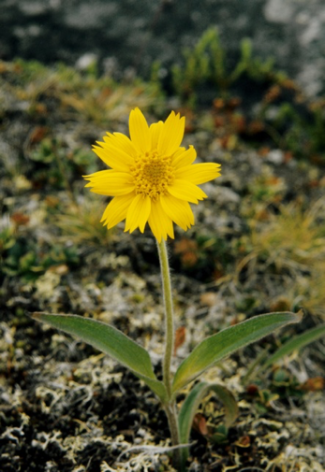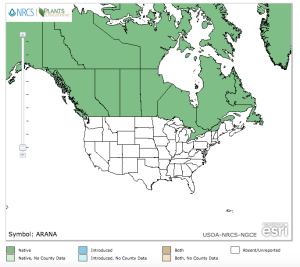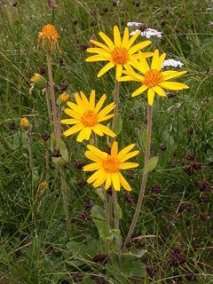
Narrow leaf Arnica
General Information:
- Common name: Narrow leaf Arnica
- Family: Asteraceae
- Considered an arctic and alpine plant from the sunflower family
- Duration: Perennial
- Habit: Herb
- Leaf Shape: Linear
- Leaf Pubescence: Glabrous (Smooth; hairless)
- Bloom Color: Yellow
- Native to colder regions in Europe, Asia, and North America (north and west Canada, Alaska, and northern Rocky Mountains)

Native Distribution of Narrow Leaf Arnica
**For this section I used information on the Arnica Montana since no info was found on Narrow leaf arnica*

Arnica Montana
History:
- Used for medicinal purposes in Europe since the 1500’s and by Native Americans since an early, but uncertain date.
- Used extensively in European folk medicine. Some would drink arnica tea to ease angina (severe chest pains due to inadequate blood supply to the heart) in old age.
- A folklore says that humans discovered arnica while observing mountain goats who would search for arnica after stumbling/falling.
- Traditional Use:
- Originally, the entire plant was used including the roots, often internally for a variety of conditions.
- Later, just the flower heads alone (fresh or dried) were used either as a tincture (dilute alcoholic solution) or an ointment. These forms were used externally only due to the several cases of arnica poisoning when used internally.
- The ointment and tincture were used to reduce inflammation and pain from bruises, aches, and sprains.
- If properly diluted, can be used as a mouth wash for mouth soars or to gargle for sore throats.
Constituents:
- Sesquiterpene lactones (main component)
- ex. Helenalin–found to produce anti-inflammatory and pain relieving effects. Also known as an allergen which can cause skin conditions depending on the concentration and delivery medium.
- Flavanoids
- Phenolic acids
- Essential oil
- Other ex. tannin
Warnings: Poisonous! Not to be used internally; can have toxic effects that may lead to death. Should not be used on open wounds or broken skin.
Current Research:
*There is currently little research being done with the narrow leaf arnica or the arnica montana. A few studies that have looked at Arnica are described below.
- Arnica montana was used as a homeopathic treatment for women going through post-operative inflammation due to a total mastectomy. Conclusion: A. montana 1000K could reduce post-operative blood and seroma collection.
- Arnica montana along with other various herbs were made into a powder to treat chronic wounds. Conclusion: supported the use of powder to ease the symptoms of chronic wounds
- Looked at the main chemical constituent of Arnica, helenalin, and its immunotoxic effects. This study lead to the making of a risk assessment of the substance.
Online Sources:
http://www.wildflower.org/plants/result.php?id_plant=ARANA
https://umm.edu/health/medical/altmed/herb/arnica
http://www.arnica.com/about-arnica/history/arnicas-humble-beginnings/
https://www.ncbi.nlm.nih.gov/pubmed/28163953
https://www.ncbi.nlm.nih.gov/pubmed/28105900
https://www.ncbi.nlm.nih.gov/pubmed/27998807
Other Sources:
Varro, Tyler E., and Steven Foster. Tyler’s Honest Herbal: A Sensible Guide to the use of herbs & related remedies. 4th ed. New York: MJF , 1999. Print.
Wyk, Ben-Erik Van, and Michael Wink. Medicinal Plants of the World: An Illustrated ScientificGuide to Important Medicinal Plants and Their Uses. Portland: Timber, 2010. Print.
Andrew, Chevallier. Encyclopedia Of Medicinal Plants. N.p.: n.p., n.d. Print.
Page created by Katherine Connelly

